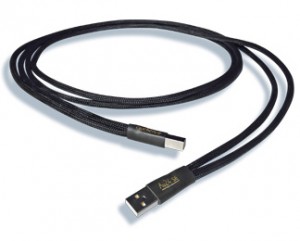
The Audience Au24 SE USB cable
This revolution will not be televised
Franco Vitaliano

Love electrons. So did Edison. So much so he and his DC co-conspirator Harold Brown would travel around the country popping stray dogs on an AC griddle and hit the switch. Ouch. Herr Thomas was convinced that once citizens saw the evils of Tesla’s puppy-frying high voltage AC they would flock instead to his low voltage DC invention.
Only problem was his wimpy DC could run down its thick copper wires about as far as you could throw a rock before it keeled over. Edison's solution of one for every mile radius DC power plant would spread like electric measles across a hapless city.
But AC was a long distance champ and once pumped up could effortlessly travel many, many miles over way thinner wires. You just had to step it down before you plugged in the electric hair dryer, or else capital root punishment. Tesla won the energy distribution day, thanks to his goombah, Westinghouse, who in the end financially whacked Tesla, anyway.
Electrons are quantum mechanical. They live in a mad fuzz-ball of indeterminate states, and thus can be in an infinite number of places simultaneously.
When you mess with anything quantum mechanical even the simple act of observing totally slams classical reality. So when the guru dude says all audio wires are equal when it comes to passing the electron hat from source to destination, they are the ones living in seriously fuzzy thinking.
Everything in the physical world is Alice-upside down in the quantum. The rules of classical reality and audio engineering are all merely apparent, not actual. It’s alchemy, and the people making really good audio wires are today’s magicians.
All of which brings us to today’s piece of audio wire wizardry, the Au24 SE USB cable from Audience. This remarkable wire does speak with a forked tongue, however. Figuratively, that is, as it is divided into two separate wires, one carrying the audio signal and the other the power. The two strands in my particular review sample were terminated at a common USB connector. But why two?
AC uses time varying voltage. So, by sinusoidally varying the voltage you can alter it, and voila, an audio signal (or telegraph, radio, TV, etc., etc.) In other words, you can transmit information over AC.
Given that electrons are quantum nut jobs do you really want the on steroids power electrons bitch-slapping their fragile musical bros? So Audience made quantum gang peace and separated them into their own wired up hoods. The result is musical bliss, indeed, much more than that.
I used a Windows 10 PC as the component source. It was hooked up by a plain vanilla USB wire. If this setup were any more desperately baseline it would be on a leaking dinghy and emigrating to Germany. In went the Au24 SE USB cable. I then hooked everything up to the, oh, so excellent, USB DAC input of an Oppo BDP-105D.
Boom! The cheek to jowl musical tenements collapsed in a heap and the view out the audio window suddenly showed a vast sonic expanse. Audience’s soundstage carpenters fashioned a new sonic space that seemingly went on forever. The Au24 SE then populated this instantly broad musical horizon with clearly observable, well defined performers doing their thing in 3-D space. And they weren’t all up in your grille. Not laid back, either, just comfortably there.
The whole experience ranks right up there with finding a cold Corona on the parched road to Damascus.
A lot of things went into making this musical revelation happen. The Au24 SE first set the audio table with deeply chiseled bass, and spread out on top was a beautifully textured layer cake of upper bass, mids and highs. Those with sophisticated musical palettes will not be left wanting.
If you revel in resolution you also won’t be disappointed. The best part it’s done without all hard-edged prancing and preening; damn, details be so shapely fine.
I used various types of audio source material on the PC, including uncompressed WAV files, high rez files, and Tidal running at its optional high resolution FLAC 1411 setting. I also used JRiver’s Media Center software (2.0) player running in Oppo Kernel mode.
The Au24 SE didn’t hesitate to show the differences. High rez 176.4kHz/24-bit recordings and the Au24 SE knocked it out of the park. My full range ribbon Analysis Omega speakers (think Greek-made Apogees) sucked up the AC from the mighty Magtech amp and together blew the bigoted wire mavens straight to the curb.
Then there is Tidal, streaming FLAC/ALAC 44.1kHz/16-bit@1411kbps, which is CD quality equivalent. When switching between Tidal’s lowest quality streaming mode, AAC+ 96 ($9.99/month) and FLAC ($19.99 month) it was manifestly obvious with the Au24 SE in the loop that if you have the audio gear goods spending the extra few bucks a month is well worth it.
Let’s talk vocals, Leonard Cohen, in particular. His voice in all its gravelly pathos was a vivid apparition daring you to go ahead, just stare into this poetic abyss. Female vocals fared equally well, be it pop, rock, jazz or classical. If ever there was an argument for goose bumping gender equality this is it.
So much do you have to drop on this few Oz’s of cable if you want this supremo musical high? It’s $945 for a one-meter dual-end (two USB connectors) Au24 SE cable and $895 for a single-end (one USB connector) cable. This is some dead serious dough. That said, I don’t know of anything else in the high end that costs less than a grand and brings back such seriously musical pleasure.
This quantum revolution will definitely not be televised.
21st, The VXM Network, https://vxm.com